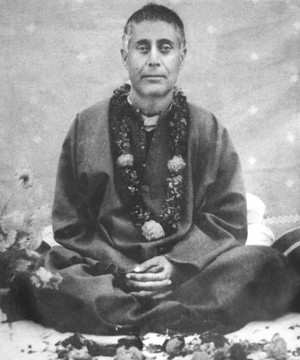1.- The recognition of the Being of Kashmir Shivaism
Kashmir Shaivism promotes the (personal) recognition that we are one with Shiva. It is the monistic (non-dualistic) tradition most linked to the Advaita philosophy of the existing Shivaite Schools.
Kashmir Shaivism appeared in the 9th century in the Kashmir region of northern India. At that time, the region was a conglomerate of small feudal kingdoms ruled by Maharajas, who supported, with their politics, the various religious traditions established in that rich and multicultural society.
The philosophical school of Kashmir Shaivism fully developed in the valley of the same name, among the beautiful mountainous landscapes. This quiet region saw the birth of a philosophical thought that forged a new sense of the transcendent.
It is said that the followers of this tradition find God within, who reveals himself after discovering the most absolute silence. We can elucidate that a form of timeless spirituality crystallized in these mountains.

The wonderful natural phenomena of the Kashmir Valley are permeated with the Consciousness that is behind all thought.
This is the reason why Kashmir Shaivism, unlike other philosophical branches, renounced all “orthodox” dogmatic and ethical disciplines, advocating effective practice, Yoga that would lead them to the effective union with Shiva. An experience that lasts by a deep and intense feeling of love for God, Bhakti Yoga.
You collaborate with this blog by buying incense and essences in our online store Inciensoshop. The selection that we offer you in this link is very appropriate for the practice of Bhakti and the realization of Consciousness.
2.- What is the contribution of the Kashmir Valley to this philosophy?
Life in the Kashmir valley offered a simple and detailed path to achieve Self-realization in this life. At that time, the Kashmir region with a simple irrigation system, the basic necessities for living could be ensured. Shivaite philosophy remained just as simple.
Shivaism does not focus on torturous practices for the body or the mind, the senses or the breath, as other traditions and philosophical schools of India manifest.

Kashmir Shivaism promotes precise methods of meditation, free from the restrictions of the mind and emotions, and that allow access to the experience of non-duality with Consciousness (Shiva).
These meditative practices and techniques gradually sublimate the emotions and the mind. Also to go transcending the low instincts and worldly attachments, leading the practitioner to a state of detachment from the body and from the ego itself. Generally, this meditation practice was preceded by other stages of practice of the Yoga system.

The natural beauty of the Kashmir valley inspired poets, poetry that influenced most of the practitioners and teachers of Kashmir Shaivism.
Kashmir Shivaism has as a result of meditation and deep experiences, access to the disidentification of Samadhi. And from there to the fourth state, Turiya, revelation and identification with Consciousness, the final step, where the cycle of reincarnation and death ends.
3.- The 64 philosophy systems established by Shiva
3.1- The bases of Shivaite philosophy
According to the tradition of Kashmir Shivaism, Shiva established 64 systems of philosophy, some monistic (or non-dualistic), others dualistic and very few monistic–dualistic. As some of these systems were lost over time, Shiva asked him Sage Durvasa to bring this knowledge back to life.
Durvasa’s sons were his disciples, and he gave them the knowledge to pass on in their turn as follows: Tryambaka was the monist (or non-dualist); Amardaka the dualist, and Shrikantha the monist-dualist.

Therefore Tryambaka is said to have laid the practice and non-dualistic foundations of the philosophy of Kashmir Shaivism. It is said that Shiva himself felt the need to resolve the conflicting interpretations of the ancient holy scriptures, the Agamas, and cast off the dualistic influence of non-dualistic doctrine.
3.2- The appearance of the Shiva Shutras
Around the eighth century, it is said that the great sage Vasugupta lived on Mahadeva Mountain, near Shrinagar. Tradition details how one night Shiva appeared in his dreams, and revealed to him the secret place where a carved sacred writing was found. in stone

When Vasugupta woke up, he went to that place and found 77 verses carved into a rock, which became the Shiva Sutras. After Vasugupta revealed the verses to his disciples, and thus and gradually this sacred teaching spread.
On the basis of teaching, the Kashmir Shaivism school was called Trika, which means triad. At its base it refers to Shiva’s three forces: will, knowledge and action.
It also refers to Shiva (the Awareness), his Shakti (the energy that complements him) and the limited individual (who remains ignorant). On the other hand, there are the three levels of psychological experience of the subject, the one who knows, the knowledge itself and the known object. Finally, there are three paths to access Absolute knowledge: the superior or divine path (iccha), the intermediate path of energy (jnana) and the inferior path of the individual (ânavopâya).
4.- The sacred scriptures of Kashmir Shaivism
The sacred scriptures related to Kashmir Shaivism are divided into three: the Agama Sastra, the Spanda Sastra and the Pratyabhijna Sastra.
The Agama Sastra are a compendium of philosophy, practices and topics related to spirituality that provide a unified doctrine. These texts include works considered divinely inspired, particularly the Shaiva Agama scriptures, including the Shiva Sutras. The Shiva Sutras are of paramount importance, a compendium attributed to the sage Vasugupta (circa 850-900 AD).
The Spanda Sastra elaborated the principles of the Shiva Sutra, but in the same way, they provide a logical reason in support of them, especially with the Spanda-Sutra or the Synuda-Karikli, also attributed to Vasugupta.
Finally, the Pratyabhijna Sastra are the philosophical branch of Trika. The logic of the system and its points of view are provided in these texts. The doctrines of other schools are also refuted. These scriptures develop the principles expounded in the Shiva Sutras. An exponent of the Pratyabhijna Shastra is the text of the Shiva Drishti, the work of Somananda, and the Pratyabhijna Sutra, written by the sage Utpaladeva.

Abhinavagupta (about 950-1000) is probably the most prominent figure in Kashmir Shaivism, having written nearly 40 works, including the Tantraloka, a compendium text of philosophy and ritual.
“The mind is seen as a hierarchical family (Krama) of agents (Kula), which spontaneously perceives the true self (Pratyabhijna), with a creative power that can be perceived as a pulsation (Spanda).”
5.- How Kashmir Shaivism was established
Kashmir Shaivism established itself as an important philosophical school due to brilliant sacred works. Kashmir Shaivism offers a rich and detailed understanding of the human being, the mind, and the path to self-realization.

Throughout history and in the different Shivaism lineages, Siddhas appeared, people who had traveled the path of self-realization, and who had freed themselves from the cycle of birth and death. It is said that Abhinavagupta himself, after finishing his last writing, entered a cave together with 1200 disciples to disappear into the Absolute, since there were no remains left and they were never heard from again.
This Shivaite system is intensely non-dualistic. He does not deny the existence of gods. However, it emphasizes meditation and self-inquiry by the practitioner and guidance by a Guru (teacher).
The creation of the world and of the individual soul is explained as a manifestation and division of consciousness itself. When we access Shiva, we can reabsorb ourselves in the vibration that Shiva himself generates to manifest creation.
Shiva is immanent and transcendent. But at the same time, through his Shakti, he performs the five actions: creation, preservation, absorption, revelation and concealment.
Kashmir Shaivism does not have the purpose of worshiping a personalized God. His goal is to reach the transcendental state of Absolute Consciousness. The spiritual practice, Sadhana, leads us to disidentification with the object and reality, until the Absolute I (Shiva) is revealed to us and we are one with everything.
6.- The three paths to reach the supreme Consciousness
The first of them is Anavopaya: this level is to maintain ourselves in a Yogic attitude, maintaining these principles and a yogic effort and mental purification, through the control of our mind.
The second level is Shaktopaya: we maintain constant attention focused on Shiva, through discrimination of what is real and what is not.
The third level is Shambhavopaya, here the Yogi instantly reaches the Supreme Consciousness through an unbreakable will. This is due to the instruction of the Guru who discerns between the individual identity and Shiva himself.

There is also a fourth path, Anupaya, in which the Yogi accesses the spontaneous recognition of the Being. On this path, nothing needs to be done, achieved, or accomplished, except to remain in one’s own self, which is Shiva.
The realization depends on a Sadguru, whose grace is the flower that crowns the Sadhana (spiritual practice). The geographical isolation of the Kashmir valley and the late muslim domination they are responsible for this knowledge remaining hidden from the eyes of the world.

Swami Lakshman Joo represents the original tradition (Parampara) of Kashmir Shivaism, and thanks to his enlightenment and teaching, today we can follow the path of Self-recognition.
It is not known how many yogis in the world formally follow this philosophical tradition, although Kashmir Shaivism remains a major influence in India.
Many adherents of Kashmir Shaivism left the valley to find residence in Jammu and other places in North India. This diaspora of Shivaite scholars and sages maintain the spread of the teaching.